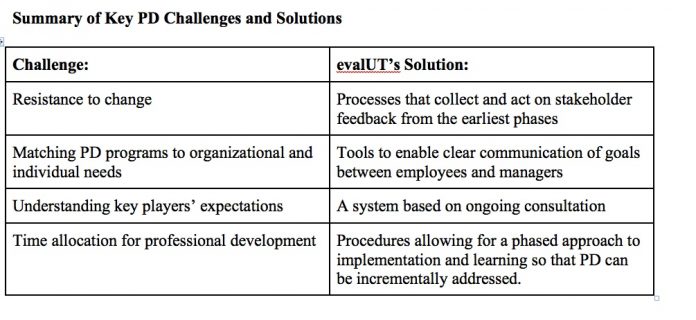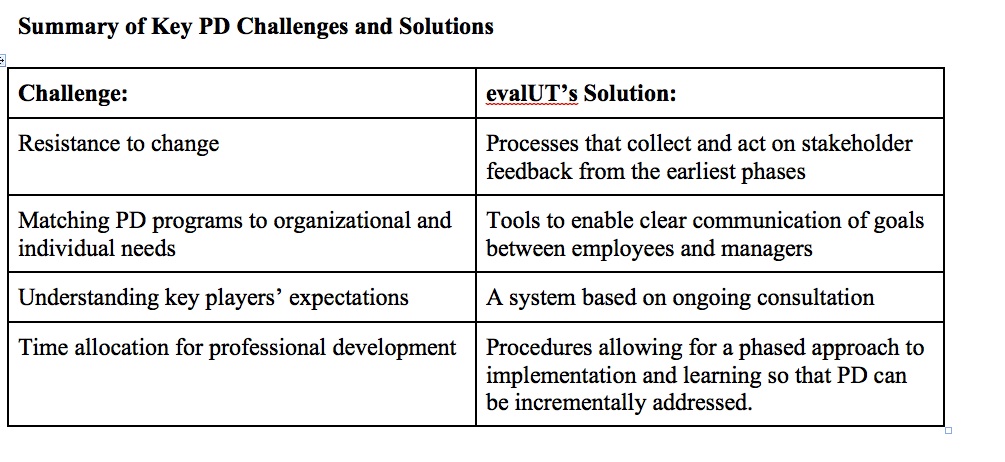
As you may know, increasing business growth and employee performance begins with the assessment and continuous improvement of your professional development (PD) programs. But organizations face many challenges on the PD path to a good-to-great transformation. Resistance to change, appropriate time allocation for training, and PD offerings ill-suited to employees are a few obstacles decision-makers are likely to encounter when implementing PD programs.
Just like corporations, large academic institutions are striving for continuous improvement. Businesses seek to engage employees and universities strive to boost student engagement and learning. Teaching and learning excellence are constant priorities in academia, whereas the quality of a company’s professional development programs is a top concern for business.
In fact, many of the same principles that help academic institutions further teaching and learning excellence are relevant within a corporate context. Here, we will look at research findings in academia that apply to professional development assessment in a corporate context.
Improving Professional Development Programs
The University of Toronto (U of T) is home to more than 80,000 students and 20,658 faculty and staff across three campuses. As such, the university needs a robust system that can satisfy both administrators and instructors by seeking student feedback on teaching and learning priorities. With no available solution to meet its needs, U of T developed its own evidence-based framework, evalUT, over a period of four years.
The core of the evalUT framework is based on a cascading concept, which allows for a balance between standardization and customization to assess teaching, taking into consideration individual and organizational priorities. It addresses assessment challenges, such as diverse teaching needs, goals, and timelines.
The data received enables university stakeholders to focus more directly on areas of improvement and align these improvements to the university’s overall goals. Instead of having 33 assessment tools across all divisions, including online and paper evaluations, the University of Toronto has been implementing a centralized system that provides both standardization and flexibility while engaging key stakeholders in the assessment process.
Several universities already have adopted evaluUT. eXplorance, provider of Learning Experience Management solutions, saw the framework’s positive impact on its clients’ efforts and decided to make the evalUT framework available to its global client base, comprising academic institutions and businesses.
Below are some of the key ways in which the processes guiding a framework like evalUT can help businesses’ PD programs stay aligned with their goals.

Understanding PD Needs
In order to determine which PD programs would be most beneficial for your company and employees, communication is important before and throughout the professional development process. Naturally, in larger organizations, clear and constant internal communication can be a challenge. The goal of PD is to build on employees’ existing knowledge and support their ongoing desire to engage in continuous learning.
A framework such as evalUT offers useful tools to ensure that smooth communication occurs between different stakeholders of different departments and units across the university. As such, it facilitates ongoing consultation, clarifying needs and goals. This way, employees don’t lose sight of individual priorities as they keep the main organizational goals in mind.
Managing PD Changes and Resistance to Change
Some employees or managers might not want to participate in proposed professional development activities. How do you overcome or reduce resistance? When a large organization undertakes sizeable professional development changes, a solid foundation of shared priorities aligned with common/individualized goals is essential to successful implementation.
The evalUT framework suggests developing buy-in for changes from stakeholders at the start of the process. The framework is grounded in the principle that all stakeholders have a role to play in the change initiative, and that the buy-in occurs continuously and at each stage of the change process.
For example, representatives from all divisions formed a working group early on to provide input related to the development of the new framework, while ongoing representative committees advise on the phased implementation process. Such processes enable a dialogue with key players who may oppose the change and, yet, are key to its ultimate success.
Focusing on Data-Based Improvements
When organizations move to automated processes, such as the online aspects of evalUT, they will be able to reduce time and energy previously spent on manual, paper-based processes. As such, reporting becomes more efficient, creating opportunities for data analysis not previously possible. This frees up time for decision-makers to focus on how to improve teaching and learning based on the data provided.
Indeed, data collected from PD programs can serve to better target participants’ areas of interest, strengths and limitations, and grasp of the new ideas and skills to be learned. The data then can allow managers to make decisions that cater specifically to the needs of their teams.
The Cascaded Concept for PD Program Assessment
Bottom line: A cascaded framework can help large organizations make better professional development decisions, leading to continuous improvement and highly trained employees, benefiting the entire organization while keeping individual department and individual employee needs in mind. As overall priorities are assessed at many levels, businesses are better able to work toward their future goals.
Professor Carol Rolheiser, Ph.D., brings a wealth of teaching and administrative experience to her role as director of the Centre for Teaching Support & Innovation (CTSI) at the University of Toronto. CTSI is a hub for leadership in teaching and learning for all of the university’s teaching staff. Prof. Rolheiser’s expertise also has been sought after by organizations around the world, including in Canada, the United States, Japan, Korea, Australia, and Central and Eastern Europe.




